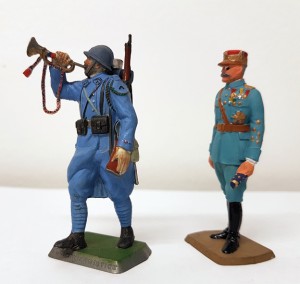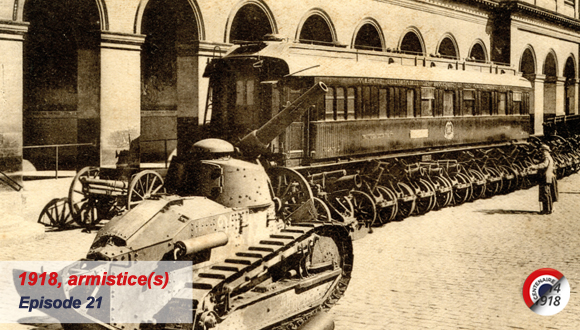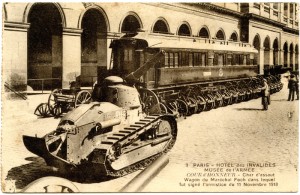Postcard printed by the Society of Friends of the Musée de l’Armée. A Renault FT tank, which has become one of the symbols of victory, is shown near the carriage. Artillery pieces form a protection zone around the carriage, preventing “attacks” from any tourists who would like to be photographed near the entrance, instead of Foch. © Paris, musée de l’Armée
 Waterman pen-holder used for the signature of the armistice and manufactured in the United States between 1900 and 1918. The lightest is the one used by Foch. The second, in dark wood, was used by German plenipotentiaries. Both were kept by Foch, then deposited in Musée de l’Armée by the descendants of the Marshal, on 24 April 1981. In 2010, they were donated by Henry Fournier-Foch (1912-2006) and Rémi Bécourt-Foch (born in 1938). © Paris, musée de l’Armée, dist. RMN-GP / image musée de l’Armée.
Waterman pen-holder used for the signature of the armistice and manufactured in the United States between 1900 and 1918. The lightest is the one used by Foch. The second, in dark wood, was used by German plenipotentiaries. Both were kept by Foch, then deposited in Musée de l’Armée by the descendants of the Marshal, on 24 April 1981. In 2010, they were donated by Henry Fournier-Foch (1912-2006) and Rémi Bécourt-Foch (born in 1938). © Paris, musée de l’Armée, dist. RMN-GP / image musée de l’Armée.
 The armistice bugler and Marshal Foch are part of the 7th series of historical advertising figurines made in the late 1950s and offered in Mokarex coffee packages. They are presented in the Cabinets of Extraordinary Objects at the Musée de l’Armée. © Paris, musée de l’Armée.
The armistice bugler and Marshal Foch are part of the 7th series of historical advertising figurines made in the late 1950s and offered in Mokarex coffee packages. They are presented in the Cabinets of Extraordinary Objects at the Musée de l’Armée. © Paris, musée de l’Armée.
Hôtel des Invalides
The destiny of a restaurant-car
Built in 1914, restaurant car 2419 D began to circulate in June. In September 1918, it was requisitioned by the army, then transformed into a lounge-office-wagon, in the Saint-Denis workshops. In October 1918, it was incorporated into the train of the great headquarters at the disposal of Marshal Foch. After the armistice was signed, it was still used during the three extensions of the armistice signed in Triers. In September 1919. It was returned to the Compagnie Internationale des wagons-lits, which refitted it as a restaurant car.
At the behest of the Government led by Clémenceau, the Compagnie Internationale des wagons-lits donated it to the State. On 1 October 1919, an agreement was signed to this effect. The President of the Republic, Alexandre Millerand, was on board when it travelled to Verdun on 8 December 1920. It was then placed in the north-east corner of the main courtyard of the Hôtel des Invalides from 28 April 1921 until 8 April 1927. The wagon deteriorated and from 1924, General Mariaux, then director of the Musée de l’Armée, wrote to the Minister of War to have it placed in a shelter in «Rethondes» or at the Château de Vincennes. The Deputy Mayor of Compiègne, Robert Fournier-Sarlovèze, intervened multiple times to have the wagon come back to Compiègne. Finally, thanks to the patronage of an American, Arthur-Henry Fleming, the wagon was restored and returned to the Compiègne Wagon in the forest of the same name. On 11 November 1927, the shelter containing the wagon was inaugurated in the presence of Marshal Foch.
Another Armistice
In June 1940, the wagon brought out of its shelter and was set in the clearing. The Armistice between Nazi Germany and France of the Vichy regime was signed there on 22 June 1940. It was then transported and displayed in Berlin, then destroyed, in April 1945, upon Hitler’s orders. In 1950, a wagon of the same series, the 2439D wagon, was fitted out identically and decorated with the original furniture. It is now on display at the Armistice Memorial.
The collections of Musée de l’Armée
As mundane as they may be, the pen holder, ink and paper are essential when signing an armistice. Some of these objects were collected by direct witnesses, then jealously guarded by the families, before being donated to the national collections.



Ajouter un commentaire